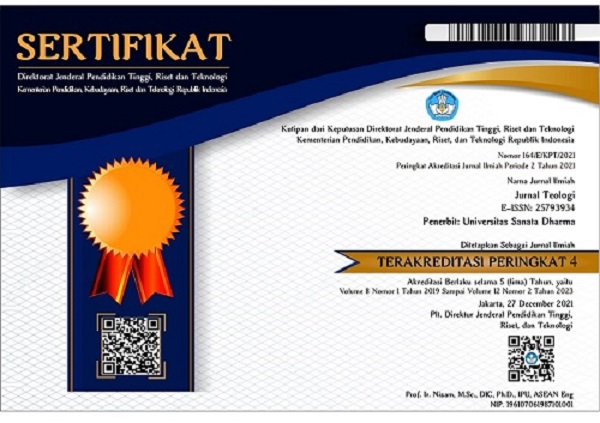PERIKANAN DANAU GALILEA ABAD PERTAMA UNTUK MEMAHAMI KAPERNAUM SEBAGAI KOTA YESUS (MATIUS 9:1)
(1) Faculty of Theology, Universitas Sanata Dharma, Yogyakarta
(*) Corresponding Author
Abstract
Kapernaum menjadi basis utama karya Yesus. Injil Mat 9: 1 menyebutnya sebagai "kota Yesus". Kapernaum adalah kota asal murid pertama Yesus: Simon, Andreas, Yakobus, dan Yohanes (Mrk 1:29). Fokus penelitian ini adalah meneliti hubungan antara pemilihan para murid pertama Yesus dari antara para nelayan Kapernaum dengan konteks perikanan Danau Galilea pada abad pertama Masehi. Mengapa Yesus memilih Kapernaum sebagai basis karya-Nya di tepi Danau Galilea? Melalui studi literatur, penelitian ini berusaha memahami industri penangkapan ikan para nelayan Kapernaum yang menjadi murid-murid Yesus dalam konteks perikanan di Danau Galilea pada abad pertama Masehi. Hasil penelitian ini membuktikan bahwa Kapernaum adalah salah satu dari sejumlah pusat ekonomi perikanan di tepi Galilea. Perikanan Galilea tumbuh seiring bertambahnya permintaan produk ikan pada masa itu. Yesus memilih nelayan Galilea sebagai bagian inti dari kedua belas rasul-Nya karena mereka terbiasa bekerja sama dalam paguyuban nelayan, mampu berkomunikasi dengan baik dan terhubung dengan banyak orang dalam konteks penangkapan ikan yang ramai pada abad pertama Masehi di Galilea
Keywords
Full Text:
PDF (Bahasa Indonesia)References
Callegher, B., "E le monete di Magdala ci raccontano che," Terrasanta 4 (2009): 49.
Chancey M.A., Greco-Roman Culture and the Galilee of Jesus (Cambridge UK: Cambridge University Press, 2005).
De Luca, S dan Lena, A., “Magdala/Tarichae,” dalam Galilee in the Late Second Temple and Mishnaic Periods, Volume 2: The Arcaeological Record from Cities, Towns, and Villages (ed. D.A. Fiensy dan J.R. Strange [Minneapolis: Fortress, 2015]): 280-342.
Fassberg, S.E., “Which Semitic Language Did Jesus and Other Contemporary Jews Speak?” The Catholic Biblical Quarterly 74, no. 2 (2012): 263–80.
Fradkin, A., “Long-Distance Trade in the Lower Galilee: New Evidence from Sepphoris,” in Archaeology and the Galilee: Texts and Contexts in the Greco-Roman and Byzantine Periods (ed. Edwards, D.R. dan McCollough, C.T. (Atalanta, Georgia: Scholars Press, 1997): 107-115.
Freidenreich,D.M., Foreigners and Their Food: Constructing Otherness in Jewish, Christian, and Islamic Law (Berkeley, CA: University of California Press, 2011).
Gleaves, G.S., Did Jesus Speak Greek? Emerging Evidence of Greek Dominance in First-Century Palestine (Eugene, OR: Pickwick, 2005).
Hachilili, R., Jewish Funerary Custom, Practices and Rites in the Second Temple Period (JSJSup 94; Leiden: Brill, 2005).
Hakola, R., “The Production and Trade of Fish as Source of Economic Growth in the First Century C.E. Galilee: Galilean Economy Reexamined,” Novum Testamentum 59 (2017): 111-130.
Hanson, K. C., “The Galilean Fishing Economy and the Jesus Tradition,” Biblical Theology Bulletin: Journal of Bible and Culture, 27(3) (1997): 99–111.
Horsley, H.R., New Documents Illustrating Early Christianity. Vol. 5 (Macquarie, Australia: Ancient History Documentary Research Centre, 1989).
Lapide, P. “Insights From Qumran Into The Languages of Jesus,” Revue de Qumrân 8, no. 4 (32) (1975): 483–501.
Lytle, E., “Marine Fisheries and the Ancient Greek Economy” (disertasi PhD, Duke University, 2006): 68-74.
Marzano, A., Harvesting the Sea: The Exploitation of Marine Resources in the Western Mediterranean (Oxford: Oxford University Press, 2005).
Matilla, S.L., “Revisiting Jesus’Capernaum: A Village of Only Subsistence-Level Fishers and Farmers,” dalam The Galilean Economy in the Time of Jesus (ed. D.A. Fiensy dan R.K. Hawkins; SBLECL 11; Atlanta: Society of Biblical Literature, 2013): 75-138.
Meyers E.M., dan Chancey, M.A., Alexander to Constantine (New Haven: Yale University Press, 2012).
Morris, I., Saller, R.P., dan Scheidel, W., “Introduction” dalam The Cambridge Economic History of the Greco-Roman World (ed. Scheidel, W., Morris, I., dan Saller, R. (Cambridge: Cambridge University Press, 2007): 1-12.
Notley, R.S., In The Master’s Steps: The Gospel in The Land. Yerusalem (Carta Jerusalem 2004).
Nun, M., “Ports of Galilee: A Recent Drought in Israel Has Had One Beneficial By-Product: The Lowered Water Level of the Sea of Galilee Has Exposed Harbors Not Seen Since the Time of Jesus,” Biblical Archaeology Review (1999): 18–31.
Nun, M., The Sea of Galilee and Its Fishermen in the New Testament (Ein Gev: Kibbutz Ein Gev. Oppian, 1928. Halieutica, terjemahan oleh Mair, A.W., (London: Heinemann, 1999).
Raban, A., “Marine Archaeology” dalam The New Encyclopedia of Archaeological Excavations in The Holy Land vol. 3, ed. E. Stern (Jerusalem, Israel: Israel Exploration Society, 1993): 957-65.
Schürer, E., Vermès, G., dan Millar, F., History of the Jewish People in the Age of Jesus Christ (Edinburg: A&C Black, 1973).
DOI: https://doi.org/10.24071/jt.v12i02.7005
Refbacks
- There are currently no refbacks.

This work is licensed under a Creative Commons Attribution-ShareAlike 4.0 International License.
.jpg)
Indexed and abstracted in:
P-ISSN: 2302 - 5476 (Validity starting Volume 2012-10-05)
E-ISSN: 2579 - 3934 (Validity starting Volume 6, No. 1, Mei 2017)
Jurnal Teologi (Journal of Theology) by Faculty of Theology Sanata Dharma University

This work is licensed under a Creative Commons Attribution-ShareAlike 4.0 International License














